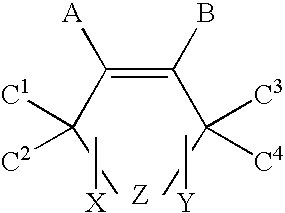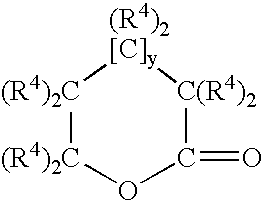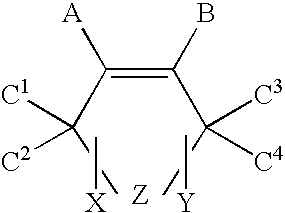Oxygen scavenger compositions
a technology of composition and oxygen, applied in the direction of containers preventing decay, synthetic resin layered products, other chemical processes, etc., can solve the problems of oxygen ingress, oxygen ingress, and importance of oxygen permeation through the body, etc., to achieve low tack, easy processing, and sufficient viscosity
- Summary
- Abstract
- Description
- Claims
- Application Information
AI Technical Summary
Benefits of technology
Problems solved by technology
Method used
Image
Examples
example 1
cis-1,2,3,6-Tetrahydrophthalic Anhydride / 1,6-Hexanediol Condensation Polymer (PA)
[0120] A 500 ml round bottom flask, (RBF), equipped with a stirrer, thermocouple, nitrogen inlet and a distillation head was charged with 156.6 g of 1,6-hexanediol (HD), 200 g of tetrahydrophthalic anhydride (THPA), 0.1400 g of trimethylolpropane (TMOP) and 0.09 g of titanium butoxide. The reaction mixture was heated with distillation at 200° C. for one hour, and then the temperature was increased to 230° C. and heated for one hour. During this time, 24 g of distillate was collected. The distillate was predominantly water, but also contained some 1,6-hexanediol.
[0121] In the second step, 0.09 g of additional titanium butoxide was added and the reaction mixture was heated to 230° C. under vacuum (0.2-0.8 mm) and held for three hours. The resulting polymer was cooled to room temperature.
[0122] GPC analysis showed the polymer had a Mn of 11,364, a Mw of 46,155, and a ratio of Mw / Mn of 4.06. The hydroxyl...
example ii
Master Batch Preparation
[0124] A master batch comprising a transition metal catalyst and a photoinitiator was prepared by a continuous compounding operation. In particular, a dry blend of poly(ethylene / vinylacetate) having approximately 9% vinylacetate content (EVA-9) was dry blended with 4,4′-dimethylbenzophenone and pellets of cobalt neodecanoate salt by introducing the materials into a Leistritz, intermeshing, twin screw extruder, equipped with a strand die. The amount of Co catalyst used provided about 1 weight percent Co (as metal) and the amount of 4,4′-dimethyl-benzophenone was sufficient to also give 1 weight percent of the master batch composition. The strand product was fed through a water bath to cool the resultant material and then was dried with an air knife. The strand was fed through a commercial pelletizer to result in a pelletized product labeled and referred to herein below as “Masterbatch”.
example iii
Polyester Condensation Polymer B (PB)
[0125] A series of polyester condensation products were commercially obtained as polymer B (PB) component of the composition of the present invention. These polymers comprise: [0126] A mixture of dicarboxylic acids composed of sebacic acid, terphthalic acid and isophthalic acid with a mixture of ethylene glycol and neopentyl glycol forming the diol portion. The product has a Tg of 37° C. This product was commercially obtained (Rohm & Haas, Morester 49006) and is herein labeled “B-1”. The hydrocarbon monomers (neopentyl glycol and sebacic acid) comprise about 40 mole percent of the total monomers. [0127] A mixture of dicarboxylic acids composed of terphthalic acid, isophthalic acid, and a minor amount of sebacic acid with a mixture of diols composed of ethylene glycol and neopentyl glycol. The product has a Tg of 66° C. This product was commercially obtained (Rohm & Haas, Morester 49021) and is herein labeled “B-2”. The hydrocarbon monomers (neop...
PUM
| Property | Measurement | Unit |
|---|---|---|
| Temperature | aaaaa | aaaaa |
| Thickness | aaaaa | aaaaa |
| Thickness | aaaaa | aaaaa |
Abstract
Description
Claims
Application Information
 Login to View More
Login to View More - R&D
- Intellectual Property
- Life Sciences
- Materials
- Tech Scout
- Unparalleled Data Quality
- Higher Quality Content
- 60% Fewer Hallucinations
Browse by: Latest US Patents, China's latest patents, Technical Efficacy Thesaurus, Application Domain, Technology Topic, Popular Technical Reports.
© 2025 PatSnap. All rights reserved.Legal|Privacy policy|Modern Slavery Act Transparency Statement|Sitemap|About US| Contact US: help@patsnap.com



